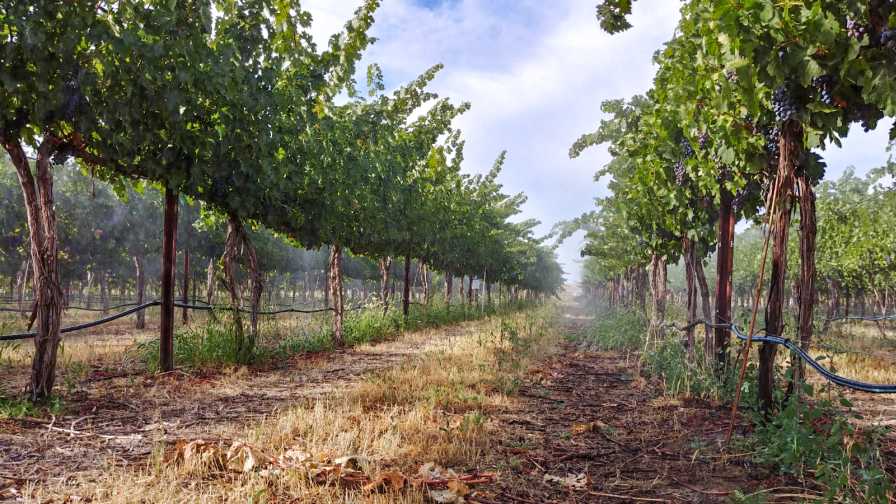How Heat Waves Impact Wine Grapes

Shoots are positioned to shade ‘Chardonnay’ grapes during ripening. This can help the crop during untimely heat waves. Photo by Esther Hernández
Washington State’s grape industry is thriving. It provides about half of the nation’s ‘Concord’ juice grapes and boasts a robust market for wine grapes, including ‘Cabernet Sauvignon’, ‘Merlot’, ‘Riesling’, and ‘Chardonnay’.
In fact, California wine stakeholders have begun investing in Washington vineyards because of rising temperatures and more frequent fires. However, Dr. Markus Keller of Washington State University’s Irrigated Agriculture Research and Extension Center, is seeing the state start to experience similar problems.
“Every year, I get calls from growers and winemakers who are concerned about the summer heat waves negatively affecting the quality of their grapes and wine and, therefore, their pocketbooks,” he says.
During a heat wave — when temperatures reach 95°F or more — grapes start shutting down, trying to conserve water. When people think about Washington, rainy Seattle may come to mind, but most of the state’s grapes are grown in the dry, Eastern portion using deficit irrigation, applying water during drought-sensitive growth stages. The combination of extreme heat with already restricted irrigation only makes matters worse.
However, the details of how heat and water stress affect grapes — especially regarding wine quality — have not been well researched.
“There are many things we don’t know about how heat affects grapes,” Keller says. “Much of what we think we know is anecdotal or based on dated research that wasn’t done at these really high temperatures. When you study grapes at temperatures in the 80s vs. in the 100s, it’s a completely different story.”
Three-Phase Approach
Keller and his team (including postdoctoral scientists Dr. Yun Zhang, Dr. Esther Hernández, and Dr. Ben-Min Chang, and graduate student Evan Fritzke) took several approaches to studying how heat and water stress affect grapes.
• Testing plants in environmentally controlled growth chambers that simulate various degrees of heat waves and water deficits
• Working with vineyards to test canopy management practices, such as leaf removal or extra shading, by covering the grapes with shoots
• Engineering solutions, such as canopy- cooling devices that use misters

A fine mist provides canopy cooling during heat waves in a ‘Cabernet Sauvignon’ vineyard.
Photo by Ben-Min Chang
Water Vs. Heat
After four years of trials, the team was surprised by how each stress factor drove different responses.
Growth chamber studies concluded that water stress is the biggest factor affecting plant physiology and growth, while temperature completely drives fruit ripening.
“While it’s been known for a while that water deficit is beneficial for grape quality, the reason really comes down to temperature, not the lack of water itself,” Keller says. “Warmer temperatures can be good for some grapes, but when it gets too hot, we get negative effects.”
Overall quality tends to suffer when it is too hot. Warm conditions early in the year accelerate grape development so that ripening starts too early, during the hot part of the summer rather than fall. This leads to high sugar content coupled with low acidity and poor color and flavor, which make for alcoholic, bland-tasting wine. Deficit irrigation provides less water, which means limited vine growth and a small canopy that does not shade grapes from the sun.
“The grape skin gets hot and sunburned, just as ours does when exposed to the sun,” Keller says.
Looking Forward
Keller seeks to continue research to optimize the cooling/misting system his team developed by collaborating with local vineyards. The goal is to water just enough so that no drops hit the ground; water should evaporate back up into the air to cool the grapes.
“There’s a fine line between just right and too much,” he says. “Growers have to be careful not to counteract a water-deficit approach by supplying excessive amounts of water during canopy cooling.”
Keller and his team are also collaborating with scientists at WSU’s Wine Science Center to make wine from the misting system to further test quality.
Some experts predict that increased temperatures may lead to much of the world’s grape-producing regions disappearing by the end of the century. Of the more than 5,000 varieties of wine grapes globally, some are well adapted to heat. But Keller is not sure that winemakers and consumers will adapt to new flavors.
However, Keller is certain of one thing — Washington is not alone in this issue.
“I speak at seminars and conferences all around the world, and heat is always a prominent topic,” he says. “From Europe to Southern Africa to the United States, we are all experiencing climate change, so we’re all facing this issue.”










